
The Kingdom of Judah was a Semitic-speaking kingdom of the Southern Levant during the Iron Age. Centered in the highlands of Judea, the kingdom's capital was Jerusalem. Jews are named after Judah and are primarily descended from it.
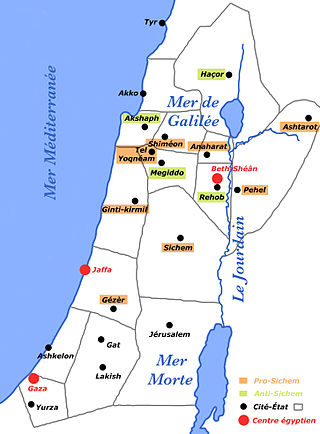
Canaan was a Semitic-speaking civilization and region of the Southern Levant in the Ancient Near East during the late 2nd millennium BC. Canaan had significant geopolitical importance in the Late Bronze Age Amarna Period as the area where the spheres of interest of the Egyptian, Hittite, Mitanni and Assyrian Empires converged or overlapped. Much of present-day knowledge about Canaan stems from archaeological excavation in this area at sites such as Tel Hazor, Tel Megiddo, En Esur, and Gezer.
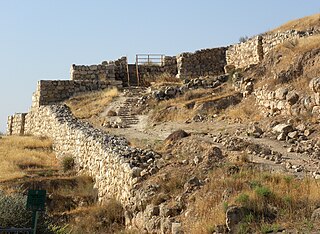
Lachish was an ancient Canaanite and Israelite city in the Shephelah region of Israel, on the south bank of the Lakhish River, mentioned several times in the Hebrew Bible. The current tell (ruin) by that name, known as Tel Lachish or Tell ed-Duweir, has been identified with the biblical Lachish. Today, it is an Israeli national park operated and maintained by the Israel Nature and Parks Authority. The park was established on lands of the depopulated Palestinian village of Qobebet Ibn ‘Awwad which was north of the Tel. It lies near the present-day moshav of Lakhish.

Israel Finkelstein is an Israeli archaeologist, professor emeritus at Tel Aviv University and the head of the School of Archaeology and Maritime Cultures at the University of Haifa. Finkelstein is active in the archaeology of the Levant and is an applicant of archaeological data in reconstructing biblical history. He is also known for applying the exact and life sciences in archaeological and historical reconstruction. Finkelstein is the current excavator of Megiddo, a key site for the study of the Bronze and Iron Ages in the Levant.

The Amarna letters are an archive, written on clay tablets, primarily consisting of diplomatic correspondence between the Egyptian administration and its representatives in Canaan and Amurru, or neighboring kingdom leaders, during the New Kingdom, spanning a period of no more than thirty years between c. 1360–1332 BC. The letters were found in Upper Egypt at el-Amarna, the modern name for the ancient Egyptian capital of Akhetaten, founded by pharaoh Akhenaten (1350s–1330s BC) during the Eighteenth Dynasty of Egypt. The Amarna letters are unusual in Egyptological research, because they are written not in the language of ancient Egypt, but in cuneiform, the writing system of ancient Mesopotamia. Most are in a variety of Akkadian sometimes characterised as a mixed language, Canaanite-Akkadian; one especially long letter—abbreviated EA 24—was written in a late dialect of Hurrian, and is the longest contiguous text known to survive in that language.
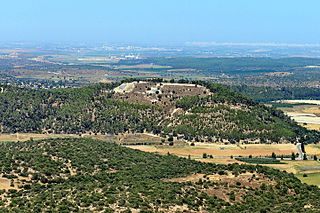
Azekah was an ancient town in the Shfela guarding the upper reaches of the Valley of Elah, about 26 km (16 mi) northwest of Hebron.
The Jehoash Inscription is the name of a controversial artifact rumored to have surfaced in a construction site or Muslim cemetery near the Temple Mount of Jerusalem.
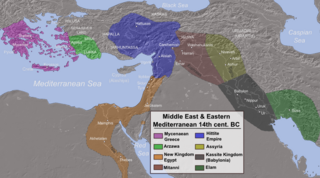
Alashiya, also spelled Alasiya, also known as the Kingdom of Alashiya, was a state which existed in the Middle and Late Bronze Ages, and was situated somewhere in the Eastern Mediterranean. It was a major source of goods, especially copper, for ancient Egypt and other states in the Ancient Near East. It is referred to in a number of the surviving texts and is now thought to be the ancient name of Cyprus, or an area of Cyprus. This was confirmed by the scientific analysis performed in the Tel Aviv University of the clay tablets which were sent from Alashiya to other rulers.

LMLK seals are ancient Hebrew seals stamped on the handles of large storage jars first issued in the reign of King Hezekiah and discovered mostly in and around Jerusalem. Several complete jars were found in situ buried under a destruction layer caused by Sennacherib at Lachish. While none of the original seals have been found, some 2,000 impressions made by at least 21 seal types have been published. The iconography of the two and four winged symbols are representative of royal symbols whose meaning "was tailored in each kingdom to the local religion and ideology".

The siege of Lachish was the Neo-Assyrian Empire's siege and conquest of the town of Lachish in 701 BCE. The siege is documented in several sources including the Hebrew Bible, Assyrian documents and in the Lachish relief, a well-preserved series of reliefs which once decorated the Assyrian king Sennacherib's palace at Nineveh.
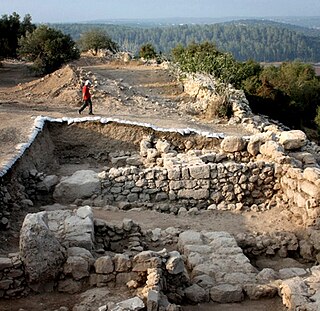
Khirbet Qeiyafa, also known as Elah Fortress and in Hebrew as Horbat Qayafa, is the site of an ancient fortress city overlooking the Elah Valley and dated to the first half of the 10th century BCE. The ruins of the fortress were uncovered in 2007, near the Israeli city of Beit Shemesh, 30 km (20 mi) from Jerusalem. It covers nearly 2.5 ha and is encircled by a 700-meter-long (2,300 ft) city wall constructed of stones weighing up to eight tons each. Excavations at site continued in subsequent years. A number of archaeologists, mainly the two excavators, Yosef Garfinkel and Saar Ganor, have claimed that it might be one of two biblical cities, either Sha'arayim, whose name they interpret as "Two Gates", because of the two gates discovered on the site, or Neta'im; and that the large structure at the center is an administrative building dating to the reign of King David, where he might have lodged at some point. This is based on their conclusions that the site dates to the early Iron IIA, ca. 1025–975 BCE, a range which includes the biblical date for the biblical Kingdom of David. Others suggest it might represent either a North Israelite, Philistine, or Canaanite fortress, a claim rejected by the archaeological team that excavated the site. The team's conclusion that Khirbet Qeiyafa was a fortress of King David has been criticised by some scholars.

Shaaraim, possibly meaning "Two Gates", is an Israelite city mentioned several times in the Hebrew Bible and the Old Testament. It has been identified by some with Khirbet Qeiyafa, an archaeological site on a hilltop overlooking the Elah Valley in the Judean hills.
Sennacherib's Annals are the annals of the Assyrian king Sennacherib. They are found inscribed on a number of artifacts, and the final versions were found in three clay prisms inscribed with the same text: the Taylor Prism is in the British Museum, the Oriental Institute Prism in the Oriental Institute of Chicago, and the Jerusalem Prism is in the Israel Museum in Jerusalem.
Nile silt or Nile mud is a ceramic paste employed widely within Ancient Egyptian pottery manufacture, sourced from local Quaternary Nile sediments.

The Azekah Inscription, is a tablet inscription of the reign of Sennacherib discovered in the mid-nineteenth century in the Library of Ashurbanipal. It was identified as a single tablet by Nadav Na'aman in 1974.

The Sargonid dynasty was the final ruling dynasty of Assyria, ruling as kings of Assyria during the Neo-Assyrian Empire for just over a century from the ascent of Sargon II in 722 BC to the fall of Assyria in 609 BC. Although Assyria would ultimately fall during their rule, the Sargonid dynasty ruled the country during the apex of its power and Sargon II's three immediate successors Sennacherib, Esarhaddon and Ashurbanipal are generally regarded as three of the greatest Assyrian monarchs. Though the dynasty encompasses seven Assyrian kings, two vassal kings in Babylonia and numerous princes and princesses, the term Sargonids is sometimes used solely for Sennacherib, Esarhaddon and Ashurbanipal.

Oded Lipschits is an Israeli professor in the Department of Archaeology and Ancient Near East Studies at Tel Aviv University. In 1997 he earned his Ph.D. in Jewish History under the supervision of Nadav Na'aman. He has since become a Senior Lecturer and Full Professor at Tel Aviv University and served as the Director of the Tel Aviv Institute of Archaeology since 2011. Lipschits is an incumbent of the Austria Chair of the Archeology of the Land of Israel in the Biblical Period and is the Head and founder of the Ancient Israel Studies Masters program in the Department of Archaeology and Ancient Near East Studies.
The Book of Joshua lists almost 400 ancient Levantine city names which refer to over 300 distinct locations in Israel, the West Bank, Jordan, Lebanon and Syria. Each of those cities, with minor exceptions is placed in one of the 12 regions, according to the tribes of Israel and in most cases additional details like neighbouring towns or geographical landmarks are provided. It has been serving as one of the primary sources for identifying and locating a number of Middle Bronze to Iron Age Levantine cities mentioned in ancient Egyptian and Canaanite documents, most notably in the Amarna correspondence.
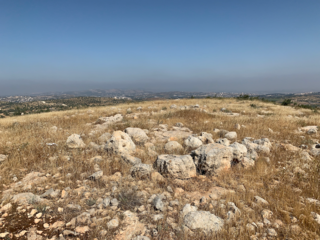
The so-called Bull Site is a 12th-century BCE open air ancient cult installation found at Dhahrat et-Tawileh, in the West Bank. The site is named for the bronze statuette of a bull which was found at the site in 1977. There is agreement that the statuette represents a sacred bull, but which god was represented by it is unclear. The statuette has been associated with the god Baal.